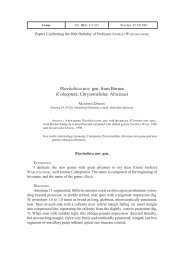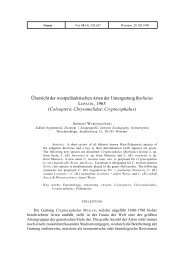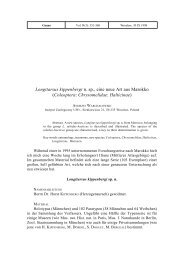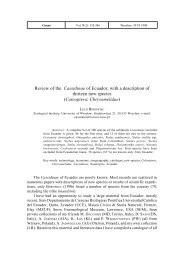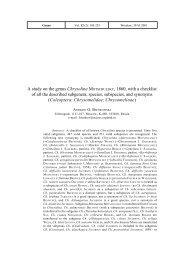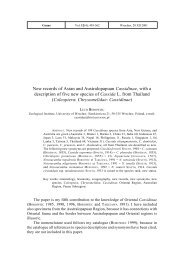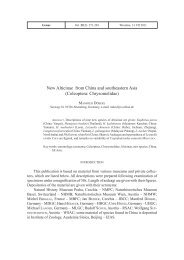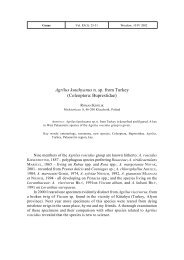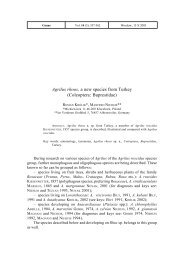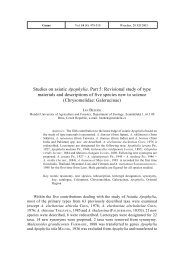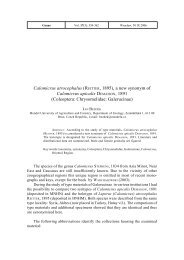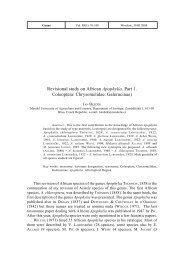Tomaszewska K. W.
Tomaszewska K. W.
Tomaszewska K. W.
Create successful ePaper yourself
Turn your PDF publications into a flip-book with our unique Google optimized e-Paper software.
466 K. WIOLETTA TOMASZEWSKA<br />
ARROW, not with D. borneensis. The variety of M. erubescens however lacks a<br />
name, and it has no nomenclatural status while ARROW’s (1920a) name purpureus<br />
is valid.<br />
Recently, while studying the Endomychidae material borrowed from the<br />
Muséum National d’Histoire Naturelle in Paris, France (MNHN) and Naturhistorisches<br />
Museum in Vienna, Austria (NHMV), a new species from Borneo has<br />
been identified and is described here as Dryadites violaceus. At present Dryadites<br />
includes eight species, all distributed in the Oriental Region.<br />
Dryadites has been traditionally classified in the subfamily Eumorphinae<br />
(STROHECKER 1953) (=Lycoperdininae) (LAWRENCE and NEWTON 1995) and in the<br />
recent classification (TOMASZEWSKA 2000), the genus was listed as a possible<br />
member of the Lycoperdininae, but awaiting further study. Examination of several<br />
species of Dryadites (D. borneensis – including the lectotype from the Hungarian<br />
Natural History Museum, Budapest (HNHM), D. purpureus – including the<br />
holotype from The Natural History Museum, London (BMNH), Mycetina<br />
erubescens var. – holotype from Museum & Institute of Zoology PAS (MIIZ),<br />
D. concolor, and D. violaceus n. sp.) confirms the subfamilial placement of the<br />
genus.<br />
TAXONOMY<br />
Dryadites violaceus n. sp.<br />
(figs 1-7)<br />
ETYMOLOGY<br />
The name violaceus refers to the violet lustre on the elytra.<br />
DIAGNOSIS<br />
Dryadites violaceus can easily be separated from all its congeners by the<br />
elytra uniformly blackish-brown or dark reddish-brown (only apices lighter) with<br />
purple-violet lustre.<br />
DESCRIPTION<br />
Length 5.30-5.50 mm. Body rather short-oval, 1.51-1.58 times as long as<br />
wide; convex; strongly shiny; colour deeply reddish-brown with dorsal surface of<br />
head, disc of pronotum, elytra and meso- and metaventrite blackish-brown,<br />
antennomeres 3-10 and at least basal half of terminal antennomere more or less<br />
infuscated.<br />
Antenna (fig. 1) 11-segmented, moderately long and rather stout, with<br />
antennomeres 1 and 3-5 more or less elongate, and antennomeres 2 and 6-8 almost<br />
as long as wide; scape about 2 times longer than pedicel and slightly longer than<br />
antennomere 3; antennomere 3 1.5 times longer than 4 or 5; antennomere 6<br />
slightly shorter than 5 and subequal in length with antennomere 8; antennomere 7



